Robin Rowland's Blog, page 3
October 8, 2020
Prisoners of the Empire: a disappointing, cherry-picked mishmash
Earlier this summer I saw a prepublication notice for Sarah Kovner’s book Prisoners of the Empire Inside Japanese POW Camps where the Harvard University Press promotion called the book “A pathbreaking account of World War II POW camps, challenging the longstanding belief that the Japanese Empire systematically mistreated Allied prisoners.” I eagerly pre-ordered the book.
I was expecting an insightful addition to the Far East Prisoner of War (FEPOW) academic literature since it was by a Senior Research Scholar at Columbia University’s Saltzman Institute of War and Peace Studies and published by Harvard University Press. Prisoners of the Empire is profoundly disappointing. I hadn’t originally intended to write a review; I bought the book from personal and family interest. Up until now I have never blogged bad reviews, but in this case the problems of Prisoners of the Empire are, unfortunately, overwhelming.
Prisoners of the Empire contains glaring errors and serious omissions. There is substantial information in Prisoners of the Empire, but that is lost because what Kovner has mostly produced is an unfocused mishmash that fails to fulfil her stated aim of “analytic rigour that academic historians have used to examine much less consequential subjects.”
Complete review on my blog
Prisoners of the Empire: a disappointing, cherry-picked mishmash
September 26, 2020
Robert Heinlein’s nightmare vision. The US elects a dictator in 2016.
You'll find it on the Goodreads blog here
If you haven't read Revolt in 2100, you should get a copy of the book and head the warning. Although Heinlein was just starting out as a writer when he wrote the first version, the events seem closer to what is happening than Margaret Atwood's scenario in Handmaid's Tale. If enough people buy the book then the warning will perhaps get attention from the media and social media.
A couple of quotes
As the battle over the US Supreme Court looms, Heinlein wrote:
"It is truism that any sect, cult, or religion will legislate its creed into law if it acquires the political power to do so..."
And for KKK linked militias in the coming election
"Blood at the polls and blood in the streets, but [Heinlein's religious dictator Nehemiah] Scudder won the election. The next election was never held.”
Science fiction author David Brin posted a similar warning on his blog in 2017. It isn't in his Goodreads blog so here is the link to the original
August 7, 2020
Remembering my visit to Florence, Oregon, which inspired Dune
 The sun sets over the dunes of Florence, Oregon, August. 1980. (Robin Rowland)
The sun sets over the dunes of Florence, Oregon, August. 1980. (Robin Rowland)It was forty years ago, in August, 1980, that a friend and I drove from Vancouver, BC, where I was living at the time, to spend a weekend at Florence, Oregon, which inspired Frank Herbert to write the famous novel Dune.
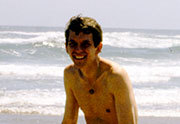 That's me at the beach in Florence, Oregon, in 1980.
That's me at the beach in Florence, Oregon, in 1980.
Like many at the time, I was entranced by Dune as soon as I picked it off a drug store bookshelf probably in 1965. It was sometime later that I read someplace that it was Florence that first inspired Frank Herbert to write about ecology when he originally visited back in 1953 when he was trying to write an article about a US Forest Service project to use dune grass to keep the sand in check. After all that research, as Herbert said in the collection of his essays,The Maker of Dune: Insights of a Master of Science Fiction: "Before long I had far too much for an article and far too much for a short story.. But I had an enormous amount of data, with angles shooting off at angles to gather more." The result, of course, was the blockbuster novel, then more novels, then spinoffs by his son, a movie concept that was never made, an awful movie that was made, a pretty good miniseries and a new movie that we hope to see this Christmas (if there are movies in theatres).
That trip has been a wonderful memory for years, so to mark the anniversary, I found some of the old slides, taken on Kodak Ectachrome, with my old Minolta SRT101 and scanned them. For a some where the colour did not survive four decades, I converted to black and white. Sand dunes and grass at Florence, Oregon, August 1980. You can see a family building a sandcastle in the distance along the shore. (Robin Rowland)
Sand dunes and grass at Florence, Oregon, August 1980. You can see a family building a sandcastle in the distance along the shore. (Robin Rowland)
 That amazing sandcastle on the beach at Florence, Oregon, that could be out of a Dune movie or perhaps a fantasy novel. (Robin Rowland)
That amazing sandcastle on the beach at Florence, Oregon, that could be out of a Dune movie or perhaps a fantasy novel. (Robin Rowland)
 Sand dunes and grass at Florence, Oregon. (Robin Rowland)
Sand dunes and grass at Florence, Oregon. (Robin Rowland)
Sand dunes are like waves in a large body of water; they are just slower. (Frank Herbert, "The Sparks Have Flown" in Frank Herbert The Maker of Dune).
 Dunes and dune grass at Florence, Oregon, August 1980. (Robin Rowland)
Dunes and dune grass at Florence, Oregon, August 1980. (Robin Rowland)
 Seagulls over the Pacific Ocean, the dunes and grass at Florence, Oregon, August, 1980. (Robin Rowland)
Seagulls over the Pacific Ocean, the dunes and grass at Florence, Oregon, August, 1980. (Robin Rowland)
June 15, 2019
Aranzazu Banks, horror on Hecate Strait, in Canadian Dreadful anthology
A mariner sailing from BC’s Douglas Channel to Haida Gwaii is seduced by mysterious lights on Hecate Stait, not knowing a seductive monster lurks off Aranzazu Banks.
My short story Aranzazu Banks appears in the new anthology of Canadian horror and magic realism Canadian Dreadful edited by David Torcher and published by Dark Dragon.
Order from Amazon Canada
Order from Amazon US
Canadian Dreadful: An Anthology [image error]
May 11, 2019
Short story Dragon Hunter in the Citadels of Darkover anthology
My short story Dragon Hunter is now available in the Darkover Anthology Citadels of Darkover, edited by Deborah J. Ross
A young paleontologist arrives on the mysterious planet Darkover with what appears to be an impossible assignment, find out if there were ever “dinosaurs” or the planetary equivalent on the planet. He faces bureaucratic resistance and has to learn the basics of cultural sensitivity on this strange planet as he searches for both fossils and love on a seemingly alien world.
Available in Canada as a Kindle E-book.
Available in the United States as a paperback or as a Kindle E-book
Citadels of Darkover (Darkover anthology Book 19)[image error]
April 5, 2018
The Baldie Starship from Time Traders

Baldie base from Galactic Derelict
My latest project is kitbashing the "Baldie" starship from Andre Norton The Time Traders universe.
Check out my modelling blog.
April 3, 2018
Tricky Things in Crossroads of Darkover
Set in the Darkover Universe, it’s the story of a young man who is faced with the dilemma of fulfilling conflicting oaths on a planet where fulfilling such an oath is a sacred duty
Author interview with Robin Rowland on Deborah Ross blog page
January 26, 2017
Kitimat Chronicles III launch

Walter Thorne at the launch of Kitimat Chronicles III. (Robin Rowland)
A big crowd turned out Wednesday night, January 25, 2017 for the launch of Kitimat Chronicles III, the third volume in the self published history of the Kitimat valley and region by Walter Thorne and Dirk Mendel, the follow up to the popular Kitimat Chronicles I and Kitimat Chronicles II (Good Reads links)
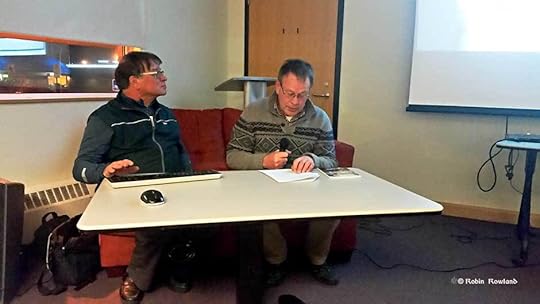
Jim and Walter Thorne at the launch of Kitimat Chronicles III, January 25, 2017. (Robin Rowland)
The stories that Walter and Derk tell include:
The story of Haisla hereditary chief and famous carver Sammy Robinson
The voyage to Douglas Channel by Spanish Captain Jacinto Caamano in 1792
The story of the Wakita family from Second World War internment to business leadership in Kitimat
The teachers who worked in the Haisla Nation Kitamaat Village in the early days
The story of Kitimat photographer Max Patzelt
The 1974 and 1975 avalanche tsunamis
The hotsprings in the region
The track of the Maori Paru from New Zealand to London to the coast of British Columbia
The more than 4,000 year history of logging in the Kitimat Valley
The life and times of former Kitimat mayor Joanne Monaghan
Kitimat’s connection to Russia, Virus Bering and the Russian trading network before the US purchased Alaska
The tense days of the 1976 United Steelworkers wildcat strike at the Alcan aluminum plant

Jim Thorne listens to the presentation. (Robin Rowland)

Walter Thorne answers questions about Kitimat Chronicles III. (Robin Rowland)
Kitimat Chronicles are available from the bookstore at the Kitimat Museum & Archives in Kitimat and Misty River Books in Terrace,
December 12, 2015
Robert Heinlein’s nightmare vision. The US elects a dictator in 2016.

The battered cover of my 1965 vintage issue of Heinlein’s Revolt in 2100, showing a big screen broadcast of the ” First Prophet” who ruled the United States in his dystopia.
In the year AD 2100, an evil Dictator rules the United States. He maintains power through the clever use of advanced science and pyschology. And he is backed by a dedicated military clique….
From Robert A. Heinlein, the dean of space-age fiction, comes this thrilling novel of a soldier who dare to defy Authority who risks his life to overthrow tyranny.
Back cover blurb for Robert Heinlein’s Revolt in 2100, paperback 1965
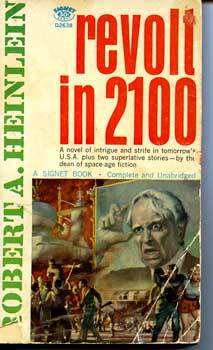
The copy of Revolt in 2100 I bought when it came out in 1965.
When American (and conservative) science fiction author Robert A. Heinlein was crafting his “future history” in the 1940s, 50s and early 60s, the timeline had a nightmare. In one of the presidential elections in the second decade of the 21st century, the voters of the United States elected a president and Congress that turned the land of the free into a religious dictatorship.
Barack Obama, of course, took the 2012 election. Wikipedia says that the election that brought the Theocracy was the 2012 race but the actual timeline graphic as published, first in the original 1953 hardcover of Revolt in 2100, is more ambiguous, just putting the event in our current decade.
Now as the race for 2016 becomes overheated 11 months before the vote, the candidates on the Republican side, Donald Trump, Ted Cruz, Ben Carson and Marco Rubio would all in someways or another, “fit the profile” of Heinlein’s greatest villain, Nehemiah Scudder, the man who destroyed American democracy in the name of God. Although Donald Trump is far from devout, his support does come from the same demographic base that Heinlein speculated could end American, democracy. Polls continue to show that the Republican base, primary voters, support Trump because, as the New York Times reports, the “most important quality in a candidate is strong leadership, which eclipses honesty, empathy, experience or electability.”
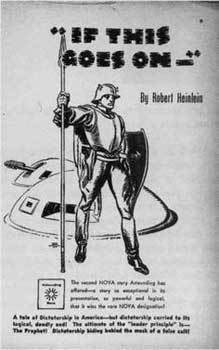
The original magazine version in Astounding Science Fiction of the novella about the Second American Revolution. “If this goes on….” 1940
Heinlein outlined just how the United States would become a dictatorship in an essay in Revolt in 2100. The bulk of the book is taken up with “If this goes on….” originally published in 1940, Heinlein’s first long form work. It tells the story of the “Second American Revolution” when elements of the United States Army mount a coup (or perhaps counter coup) to overthrow the Fundamentalist Theocracy and restore the old, abolished Constitution.
(The marketers at the publishers give it the catchy title Revolt in 2100, Heinlein’s timeline actually calls for the counter revolution to take place around 2075)
Donald Trump was denounced across the United States and around the world on Monday after saying he would bar Muslims from entering the country.
Trump was mildly criticized by his Republican opponents but more strongly even by Conservative voices such as the former Vice President Dick Cheney (whose irresponsible policies helped give birth to Daesh in Iraq) and Russell Moore of the Southern Baptist Convention although Moore’s position on what he calls “religious liberty” could protect Muslims in America but also be used to block rights of minorities, which is what Heinlein feared from the Evangelicals.
None of this criticism, so far, seems to have given any of Trump’s supporters second thoughts. The New York Times, noted that some conservative pundits and radio hosts supported and his rival for the nomination Ted Cruz “pointedly declined to join in the scolding. ‘I commend Donald Trump for standing up and focusing America’s attention on the need to secure our borders.’”
His popularity appears to be growing. Although the loudmouth Trump makes the most news with his vicious racist and outrageous statements, he is tapping into an undercurrent of rage among some, mostly white, Americans, the very thing that Heinlien feared. The other Republican candidates are also campaigning for the same voting bloc. How big is that bloc? Polls differ so what happens in the next few months must be watched closely.
Everyone assures themselves, there is no way that Donald Trump could ever become president of the United States. There are already predictions that if nominated, he would lose in a landslide probably to Hilary Clinton and with that the Republicans could also lose control of the House of Representatives and the Senate.
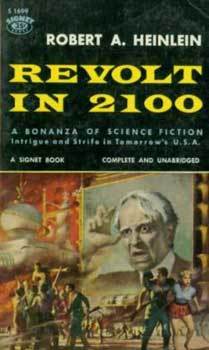
A later Signet edition of Revolt in 2100.
Heinlein’s nightmare scenario may just be possible, so it is time to look closely at what the Grand Master of Science feared so much that he never actually wrote the stories of the collapse of American democracy, which is why he called the essay “Concerning Stories Never Written.”
Heinlein cautioned that his stories “were never meant to be a definitive history of the future (concerning I know no more than you do).”
He was wrong on specifics. The timeline called for colonies on Mars and Venus ( which science fiction authors of the time hoped would be habitable) by the new millennium. “They are just stories, meant to assume and written to buy groceries.”
Heinlein explained that he would probably never write the two novels about the collapse of democracy in the United States (he never did but he did make passing references in some later novels) because “they both have the disadvantage of being ‘down beat’ stories; their outcomes are necessarily unpleasant,” adding there was already enough tragedy in the headlines of the mid-1960s. “I don’t want to write tragedy just now and I doubt if you want to read it.”
The first of the two “missing” novels was The Sound of His Wings that told the story of the rise of Reverend Nehemiah Scudder, “the ‘First Prophet,’ President of the United States and destroyer of its Constitution, founder of the Theocracy.” The second, The Stone Pillow, takes place in the period between the establishment of the Theocracy and the revolution that ends it. That downer novel would have been about “the slow build-up of a counter-revolutionary underground” whose members “rested their heads on pillows of stone—in or out of prison.”

October 2, 2015
Re-elected Harper government to crack down on dual citizens of Beringian origin
A re-elected Harper government would crack down on dual citizens originally from Beringia, sources are saying.
The sources say Harper and his advisors consider many Beringians to be a threat to Canada or at least to Harper’s vision of Canada.
According to Statistics Canada there were at least 1,400,685 residents of Beringian origin in Canada at the time of the 2011 census. Almost all those of Beriginan origin were born in Canada and are Canadian citizens by birth.
Beringians are among the fastest growing demographic group in the country.
“We know Beringians have been following well established human smuggling routes for millenia,” a source close to the Harper government said. “But like most migrants there is no immediate fear of persecution in their region of origin.”
Some of those characterized by Harper and his government as “Beringians” are disputing the claim, saying they have been in Canada “from time immemorial.”
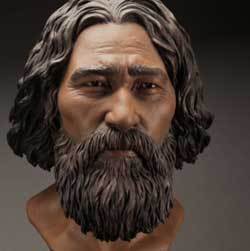
A reconstruction said to represent the notorious human smuggler known as “Kennewick.” If spotted call 911 or Crimestoppers.
The source said the Harper government has ordered both the RCMP and CSIS to search for two alleged kingpins of the human smuggling operation known by the names “Clovis” and “Kennewick.” Investigations have indicated that one of the human smuggling rings may be headquartered in the Folsom, California area.
Another smuggling route is along the rugged coast of British Columbia where the many fjords and islands are a perfect landing spot for “boat people from Beringia seeking a better economy,” according to a Conservative Party source. Bluefish Cave in the Yukon is known to be a hiding place for the illegal migrants for Beringia, the source says.
The sources say that anyone of Beringian origin convicted of a terrorist or any other anti-government activity would, after serving time in prison, would be stripped of their citizenship and deported back to Beringia.
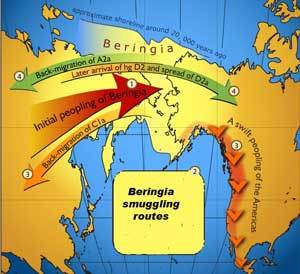
Map showing the human migration, some say smuggling, routes between Beringia and Canada.
“People like Beringians have no respect for Canadian values,” a source in Citizenship and Immigration observes. “Many consider themselves separate nations here, something which is offensive to old stock Canadians.”
Asked just how the government would deport tens of thousands of Beringians to their ancestral homeland, the CIS source said, “We’re hiring Donald Trump as a consultant, he is an expert on these issues.”
When it was pointed out what was once Beringia is part of the old Soviet Union and now Russia, one of the sources said, “Well that will be Vladimir Putin’s problem, not ours and it’s a good way to keep him busy.”
( Just so there’s no misunderstanding the era of social media. This is satire folks)







